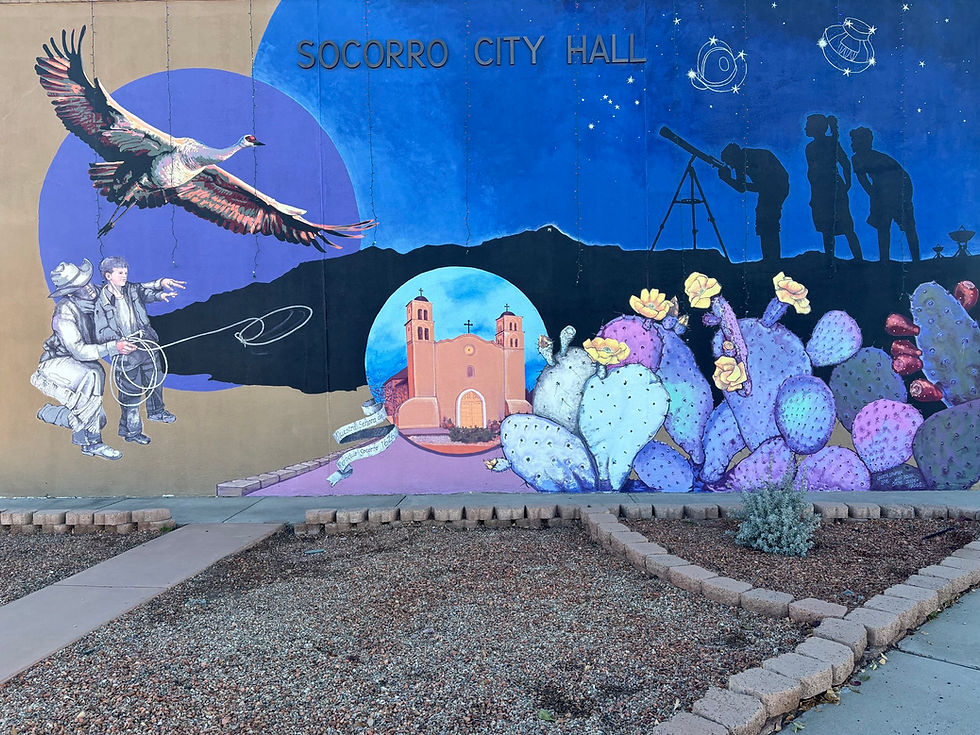Permeable boundaries
- kaydee777
- Feb 2, 2022
- 4 min read
Big Bend National Park is a place of exquisite geography sculpted by elemental things: the fire of ancient volcanic activity (E! Pele! E! Pele!) and weathering by water.

The area comes by its name because, at this point in its journey to the Gulf of Mexico, the Rio Grande makes a dramatic, swooping curve.

The river, here, serves as the USA/Mexico international border. At the time of my visit (January 2022) there was, thankfully, no border wall construction in this area. Long may it remain so. It was possible to have conversations with people on the Mexican side. Though the water was really, really low, just a trickle in places, it is illegal to cross anywhere but at an official border crossing. Voices however, cannot easily be tamed or constrained. Voices carry well across water.

Park headquarters was my first stop. The librarian had done some prior research (of course) meaning I knew I needed to arrange a (free) backcountry permit to paddle on the river. A very nice young ranger took some time to go through two pages of fine print regulations (which I had read online prior to setting out) and established that yes, I had spare paddle and spare life vest, usually called a personal flotation device in the USA. Before embarking on this journey, I purchased a bright orange, very cheap, spare PDF from my hometown big box store, anticipating this question. And yes I understood portable human waste systems were a necessity in riverine backcountry. My hope-I-never-have-to-use-it DIY version consisted of a hardware store plastic bucket with a lid, a supply of thick plastic bags, a bag of kitty litter. After that rather long class in rules, regulations and safety protocols, and though I was issued a permit, a gathering of park rangers then counseled me against paddling due to low water. Hmm.

I decided to spend the rest of the day on reconnaissance.

This led to no paddling - why put in if you are going to portage after two strokes?

However a lovely short hike to a historic hotspring pool on the river was good compensation. Of course I had hotsprings in my back pocket as healing waters plan B activity. Can’t paddle? Go soak. Sometimes life is that simple.

All that is left of the Langford Hot Springs now is some old closed off buildings, where once there was a post office, general store and hotel, and the foundations of the original bathhouse.

The trail is sandy but easy, pleasant hiking.

A few examples of ancient rock art can be seen from the trail.

Rock swallows make their homes here too.

The hotsprings are popular and the trail thus fairly heavily used. As with all National Park hotsprings and swimming holes, clothing (bathing suit) is required. Much though I detest soaking in geothermal water with clothing on and surrounded by lots of people, it is a small price to pay to soak in this gorgeous setting, with a view of Mexico just across the trickle of a river.

Along the trail, Mexican vendors set up displays of handcrafts from the villages on the other side. Selling crafts to tourists has long been an important revenue stream for these villagers. Prices are marked and one puts payment in a container.

Each stall seemed to be watched over by someone, almost invisible, in the reeds, on the river bank opposite.

Like water, humanity will find a way.

The next day, I looked at a few other possible launch spots, but none promised much of a paddle. The kayak didn’t leave the car.

Driving the park to get to river access points was an immersion in geological and Chihauhauan desert magnificence.

In one section I found volcanic ash, now solidified into rock, looking like, but not, snow.

Beautiful colours.

Miles of tuff - that solidified volcanic ash.

And one strange, out of season, ocotillo bloom.

No doubt the others will catch up.

Everywhere at suitable launch sites, the river was too low, with sandbanks or really sticky, sucking, swallow-a-cow-whole mud.

Late in the afternoon, near the Boquillas Border Crossing, I watched a group of Mexican youth playing beach volleyball on the other bank. (Hint: zoom in on river center in this picture)

They had a canoe at the ready to fetch the ball when it went into the water.

The border post closes at 4 pm. It was too late in the day for me to cross over (there’s a foot ferry) as the volley ball youth told me to do, and then get back to USA before closing. Another time.

I had to be content to buy my Boquillas rattlesnake walking stick long distance, with gestures and signs.

I hadn’t done what I had come to Big Bend National Park to do, which was paddle the Rio Grande, but I had discovered other things. I had been in the presence of beautiful landforms, wonderful xeric plants, soaked in hotsprings on the river, and looked into Mexico. I saw no drug dealers or thugs.

I had only allowed two days for Big Bend. Not enough by far.

Onward to the Gulf Coast. (Details in the next post)




Comments